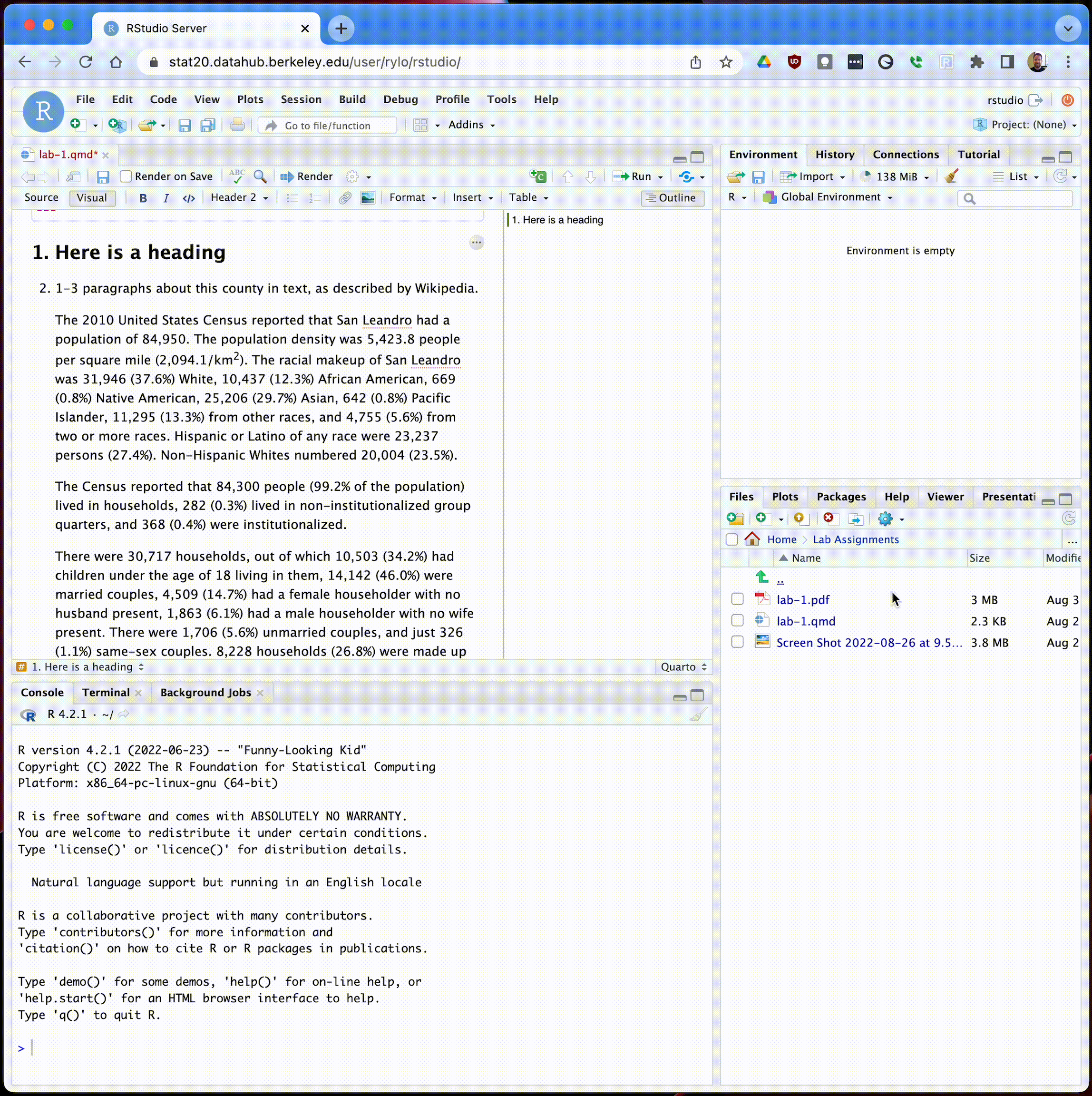Using Quarto in DataHub#
The Guide has moved!
The information on this website may be outdated as of July 2025. Please view the new curriculum guide located at https://curriculum-guide.datahub.berkeley.edu/
Quarto is an open-source publishing system that is particularly valuable for instructors who want to create dynamic, interactive course materials. Whether you’re developing lecture notes, assignments, or entire textbooks, Quarto provides a powerful, flexible platform that integrates code, data, and narrative, making it ideal for educational settings. It supports a variety of programming languages, including R, Python, Julia, and Observable JavaScript, enabling instructors to design course content that actively engages students through hands-on coding exercises and real-time data analysis.

Note
For more information about Quarto, Read here
Opportunities to Integrate Quarto in Your Workflow#
1. Creating Interactive Lecture Notes#
Use Case: Developing lecture notes that integrate code, data, and narrative.
How Quarto Helps: Quarto allows you to write notes in Markdown (.qmd files) with embedded code snippets. These snippets can generate live outputs like tables, plots, and calculations directly within the notes.
2. Building Course Websites#
Use Case: Hosting all course materials online in a single, accessible location.
How Quarto Helps: Use Quarto to render your Markdown files into a static site, which can be deployed on platforms like Netlify. This site can include lecture notes, assignments, schedules, and more. Eg: Stat 20 instructor Andrew Bray uses Quarto to generate stat20.org. Quarto is used to create and manage course materials, which are then rendered into a static website. This website is deployed on Netlify, a popular platform for hosting and deploying static sites. Netlify’s Continuous Integration/Continuous Deployment (CI/CD) pipeline automates the process of building and deploying your site whenever you update your Quarto files. This ensures that any changes you make to your course materials are automatically reflected on the live website without additional manual steps.
3. Designing Assignments and Projects#
Use Case: Creating assignments where students interact with code and data directly.
How Quarto Helps: Quarto enables you to build assignments in .qmd files that include executable code. Students can run and modify this code to complete their tasks, making the assignments more interactive and practical.
4. Automating Grading with Gradescope#
Use Case: Efficiently grading assignments that involve coding and data analysis.
How Quarto Helps: Integrate Quarto into the Gradescope autograder to automatically run and check the code in student submissions. The autograder can simulate environments like Datahub, ensuring consistency in grading.
Pathways to use Quarto in Datahub#
Quarto integrates with popular Integrated Development Environments (IDEs) such as RStudio, VSCode and JupyterLab. You can visit this website to learn more about the detailss.
RSudio: In RStudio, you can create, edit, and render Quarto documents (.qmd files) directly.
Note
Read more about it here
Jupyter: In JupyterLab, you cannot create/edit Quarto documents but can convert Jupyter notebooks to various formats using Quarto’s command-line tools.
Note
Read more about it here
VSCode: Check whether VSCode and VSCode Quarto extension is enabled in your hub. If yes, you can render and preview quarto documents and can have syntax highlighting in addition to command line tools to convert to varied documents.
Note
Read more about it here
Workflow for Beginner Instructors#
Imagine you’re preparing a lecture on data visualization. You start by writing your notes in a simple Markdown file (.qmd), adding a few basic code examples that generate charts. You then use Quarto to render these notes as a PDF handout and an HTML page for your course website.
Steps to Convert Documents to HTML/PDF via Quarto#
Convert Jupyter notebook and Quarto Markdown file to HTML#
quarto render my-notebook.ipynb --to html
The above command converts your Jupyter Notebook (.ipynb) into an HTML file.
quarto render my-document.qmd --to html
The above command converts your Quarto Markdown file (.qmd) into an HTML file.
Convert Jupyter notebook and Quarto Markdown to PDF#
Option 1:
quarto render my-homework.ipynb --to pdf
The above command converts your Jupyter Notebook (.ipynb) into a PDF file.
Option 2:
quarto render my-homework.ipynb --to typst
The above command converts your Jupyter Notebook (.ipynb) into a PDF file with a much cleaner output. It uses typst underneath.
Note
Typst is a modern typesetting system designed to provide a user-friendly alternative to traditional typesetting tools like LaTeX. It is intended for authors, researchers, and anyone who needs to produce documents with precise formatting and layout control, but without the steep learning curve often associated with traditional typesetting systems. For more details, check out typst webpage
Convert qmd file to PDF#
quarto render my-document.qmd --to pdf
The above command converts your Quarto Markdown (. qmd) into a PDF.
